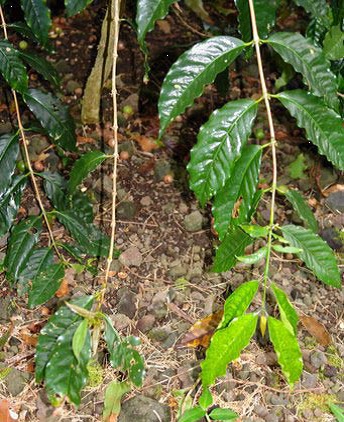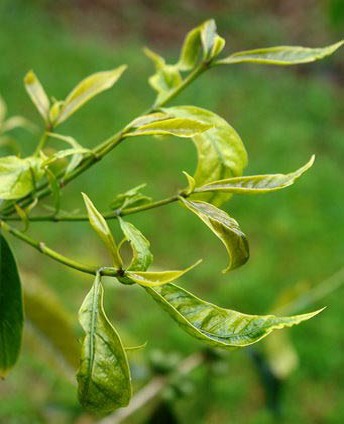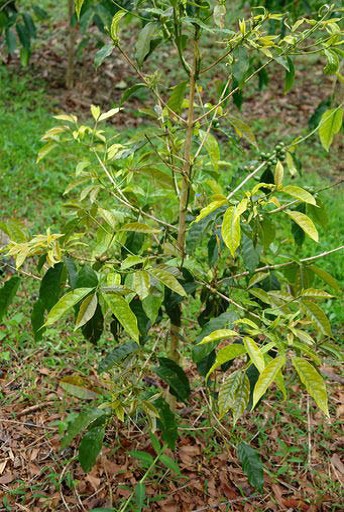Fete International Year of Soils be improving yours
The United Nations General Assembly designated 2015 the International Year of Soils. Among its objectives are educating about the profound importance of healthy soils for human life and supporting policies and actions toward the sustainable management and protection of our planet’s soils. Beyond soil health and plant health, human health is also improved when we improve our soils. An article in the Atlantic Monthly in 2013 made clear the link between our health and the health of the soil where our food grows. Go to www.theatlantic.com/health/archive/2013/06/healthy-soil-microbes-healthy-people/276710/ to read the article. To encourage practices that support healthy soil, the Kona Soil and Water Conservation District and the Natural Resources Conservation Service sponsored a Soil Health Workshop this November.
NRCS soil scientists Amy Koch and Michael Kolman discussed the formation of our unique Kona soil and ways to make or keep it healthy. As we know, healthy soil means healthy plants. Healthy plants mean a reduction in insects and diseases, which can reduce the need for treating with pesticides or spraying against diseases. Healthy soils also protect natural resources such as water and air and can help increase crop production and profits.
Healthy soils are full of life. Most of the life is in the form of microbes that are too small to see with the naked eye. Several simple practices can help keep soil alive:
— Keep the soil covered with plants, mulch or cover crops.
— Leave the soil undisturbed. Avoid tilling, grazing or using chemical products. Instead, top dress with organic matter.
— Diversify as much as possible using a variety of plants and crops or rotate crops with cover crops.
— Manage fertility and pest control in ecological ways by choosing sustainable, organic or low-tox products.
A website is available to help gardeners and farmers learn about the soil in their area. Go to https://websoilsurvey.nrcs.usda.gov and follow instructions to get a free soil survey report.
To evaluate the actual health of your soil, you may want to dig in and experience it. Healthy soil should be easy to dig into. It should be dark in color, soft, porous and moist. You may also find worms. Take a look for indicators of soil health. Feel it with your hands. It should not be dry, crusty or cloddy but should crumble as you pull it apart. Give it a sniff. Healthy soil will smell earthy and sweet rather than sour, metallic or chemical. To find the nutritional level of your soil, run a soil test. Check out the University of Hawaii College of Tropical Agriculture and Human Resources’ publication on soil testing at www.ctahr.hawaii.edu/oc/freepubs/pdf/SCM-9.pdf for instructions. Call the Cooperative Extension Service office in Kainaliu at 322-4892 to get instructions on when and how to deliver samples to them.
Two area farmers also spoke at the workshop with reports on the results of soil improvements on their property.
Robert Barnes from Kona Rainforest Coffee Farm has been amending his soil with biochar. Biochar is a highly porous charcoal created by burning organic matter. Its porosity allows it to hold water, air, nutrients and microbes for millennia. Barnes reported great increases in plant vitality from using biochar as a soil amendment. This is likely the result of the increased presence of microbes and better availability of nutrients and moisture.
Arturo Ballar from Greenwell Coffee Farms spoke about the positive effects of amending the soil on the coffee farm with microbes. The addition of microbial soil amendments has allowed the farm to reduce its fertilizer applications while also reducing herbicide use. He said combining organic and conventional farming practices resulted in excellent plant health and increased coffee production. By continuing to add soil microbes, they are hoping to soon be completely organic. Many microbial soil amendments are on the market or you can cultivate them yourself. A UH CTAHR publication “How to Cultivate Indigenous Microorganisms” is available online at www.ctahr.hawaii.edu/oc/freepubs/pdf/BIO-9.pdf.
The dependence on agricultural and gardening practices like tilling the soil, growing large areas of a single plant (monoculture), as well as applying chemical fertilizers and pesticides has reduced the diverse microbial content of our soil. A reduction in microbial activity seems to result in less healthy soil. Since most soil microbes are beneficial to plant life, increasing our soil’s microbial content is sure to make you and your plants healthier and happier.
Tropical gardening helpline
Chuck asks: My coffee trees look terrible. Their leaves are yellowing and some of the trees look like they are dying. We fertilized well this year and we are keeping the weeds down with herbicide. A recent soil test showed the presence of root knot nematode. Any suggestions on how we might revitalize our trees?
Answer: The presence of root knot nematode may well be the problem. Several different practices may help reduce the harmful nematode presence and improve the health of your trees.
UH CTAHR has a good free publication “Glyphosate Herbicide Injury to Coffee” by Scot Nelson that you might want to download at www.ctahr.hawaii.edu/oc/freepubs/pdf/PD-56.pdf. Check the photos in the publication to see if any of your symptoms match those in the pictures. If so, the herbicide applications may be adding to the problem.
Reducing all of your chemical additives may also help. Herbicides and chemical fertilizers will kill off many of the good microbes in your soil. When the good microbes are plentiful, nematode populations should go down. You can increase the microbial action in your soil in several ways.
Adding cover crops or applying mulch is a sustainable way to control weeds and each will improve your soil. Crotalaria juncea (sunnhemp) has shown some favorable results as a cover crop against root knot nematodes. It will grow tall when planted between rows and need to be weed whacked. The resulting biomass will increase microbial activity and add nitrogen to the soil, allowing you to reduce chemical fertilizer amounts. Perennial peanut is another good nitrogen-fixing cover crop to consider.
Based on some of the information reported at the Soil Health Workshop you may also want to consider adding amendments like biochar or microbes to improve the life and health of your soil. Using any or all of these remedies should improve the health of your coffee trees.
Email plant questions to konamg@ctahr.hawaii.edu for answers by certified master gardeners. Some questions will be chosen for inclusion in this column.
Diana Duff is a plant adviser, educator and consultant living on an organic farm in Captain Cook.
Gardening events
Tuesday: Tea Workshop: Quality Evaluation of Tea meets from 4 to 7 p.m. at the Waimea Civic Center, 67-5189 Kamamalu St., with Taka Ino, tea maker, discussing quality evaluation techniques based on production methods. Hands-on cupping included in registration fee of $30. Info: Perci, proque@hawaii.edu, 887-6183.
Saturday: Kohala Aina Festival is held from 3 to 9 p.m. at Inhabit Farms, 53-4223 Pratt Road, Kapaau. The event celebrates the local harvest with educational workshops, musical entertainment and farm fresh food and drinks. Cost is $35 advance, $45 at the door. Kids younger than 12 are admitted free. The tax deductible donation goes to support the Hawaii Institute of Pacific Agriculture, which provides residential farmer training and youth education programs. Donations are tax-deductible. Tickets are available at https://kohalaainafestival2015.bpt.me.





